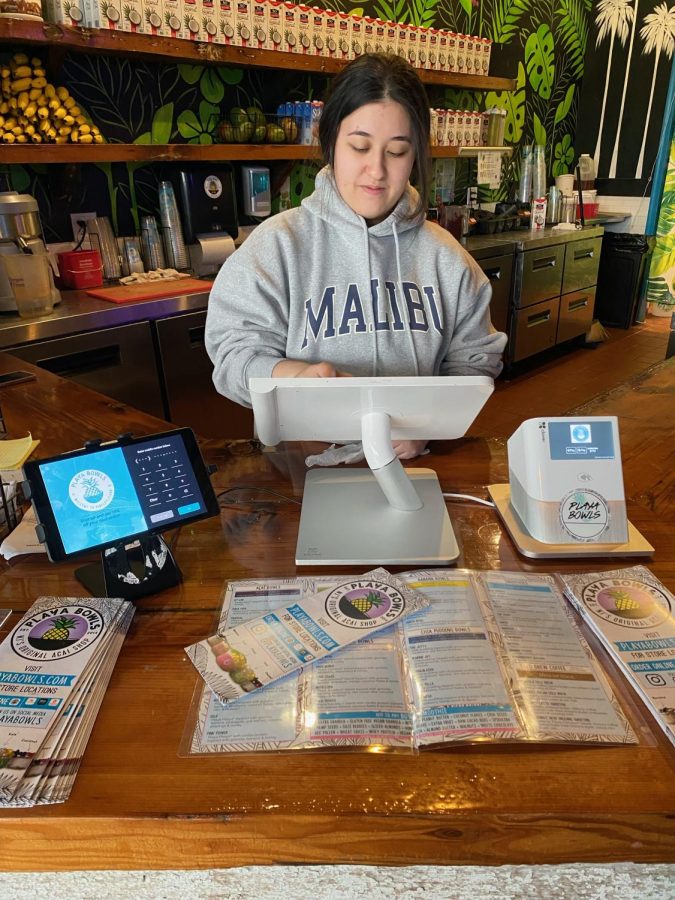New technology leads to tipping culture changes
Photo courtesy of Kendyl Groisser
Li Turner, a worker at Playa Bowls, a popular counter service restaurant in Cabin John Village, uses an electronic tablet to checkout a customer. Playa Bowls uses the tablets to make the ordering process more convenient for customers and workers, and it prompts customers to leave a tip at the end of checkout.
January 31, 2023
Picture this: you are standing in front of the counter at your local Starbucks waiting for the familiar beep that signals your credit card approval as you pay for your daily latte. Just as you are about to step away to head to the pick-up line, you are met with the turning of a white tablet. You start to panic as you look at the screen in front of you filled with options for a tip. Unsure what to do, you quickly tap the 18% option as the employee awkwardly makes direct eye contact with you. Or, maybe you select the “No Tip” option with zero shame.
Today, customers and workers alike are confronted with a radically different tipping culture than that of a few years ago. While tipping waiters at sit-down restaurants has been the norm in the United States for as long as most people can remember, the new phenomenon of tipping counter service workers like baristas seems radical to many customers.
This change can primarily be traced to the emergence of new technology meant to make the ordering experience more convenient for customers. However, these digital changes have enabled businesses to shift the task of compensating workers more directly to consumers, which has proven to be a much more intrusive method of tipping than the traditional tip jar.
These new developments have led to customers feeling pressure to tip when receiving counter service and have raised the question of how much is appropriate to tip. While some people grapple with this question every time they check out, others feel that tipping is unnecessary.
“I don’t tip at counter service restaurants with touch screens because I believe I am not being provided a service that requires a tip — it is a different experience than going to a restaurant,” WCHS senior Rubani Singh said.
While most people are used to tipping at sit-down restaurants, the phenomenon of tipping at places they are not used to has led many people to not feel pressured to tip. Tipping has never been expected at counter service restaurants prior to the last few years, so the idea of having an “awkward encounter” with a worker when choosing not to leave a tip is not a swaying factor for some.
“I do not feel awkward [not tipping] because most of the time the employee isn’t even looking,” Singh said. “If the employee is watching, I personally do not feel pressure to change my tipping behavior. However, I know many others do, as it can seem like a necessary task at the moment.”
Despite her personal views regarding tipping, Singh still believes that having a tip option at checkout does not cause any harm.
“I believe most consumers decide to tip out of respect for the service and employee,” Singh said. “I think it’s important and is often a crucial aspect for people who work these types of jobs, and having a tip option leaves it up to the customer to make a personal decision.”
Service workers are chronically underpaid. The current minimum wage in Maryland is $13.25 per hour, which is barely enough to get by, let alone provide for a family. Because of this, many workers rely on tips to supplement their salary. During the pandemic, customers were encouraged to tip generously to help struggling workers, which led to inflated expectations in the long run. Now, with customers pulling back on their tips, workers are losing a large part of the income that they previously relied on.
Dillan George, a WCHS senior and shift lead at Playa Bowls in Cabin John Village, is on the other side of the tip screen and feels that her experience as a worker at a counter service restaurant has impacted her tipping behavior.
“I almost always tip service workers when I go out to eat— I feel that they are working hard and often are underpaid,” George said. “I think people should tip at Playa Bowls and other counter service restaurants, and I think the normal amount should be in the range of 18 to 20%.”
Since there are no set tipping norms for counter service restaurants, it is completely up to the customer to decide how much they want to tip. Everyone has a different perspective on the issue, and until norms are established, there will never truly be an expected tipping amount.
“It’s hard work making tasty food, all while cleaning the store, handling customer service demands, and incoming orders and rushes, so I think receiving extra compensation is nice,” George said. “Working a customer service job has definitely shaped my perspective on food service jobs and tipping culture.”



